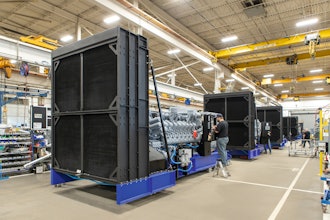At PROCESS EXPO 2015, Food Manufacturing had the opportunity to speak with Kyle Thomas, Strategic Business Unit Manager at Eagle Product Inspection, and discuss trends and topics related to product inspection in the food processing industry.
Q: How will food safety precautions and procedures change with the new global food regulations (FSMA, BRC v7, China’s food safety law)?
Food traceability is central to all new regulations and certifications such as Food Safety Modernization Act (FSMA), the upcoming Chinese Food Safety Law and the updated British Retail Consortium (BRC) global standards version 7, requiring a product to be located swiftly in the event of a product recall. For manufacturers, processors and suppliers, this means maintaining a centralized database, which can easily track a specific product batch and also help prove due diligence in relation to safety controls for any recalled product.
In the US under FSMA, if physical contaminants are identified by a company’s food safety plan as necessary to remove, preventative controls to “minimize or eliminate” the contamination must be put in place. In addition to the actual preventative controls, a system must be put in place to monitor and verify that these are effective. This is where an Eagle x-ray inspection machine comes in: to inspect, reject contaminated product and verify through data collection that controls are effective.
Q: What changes are we seeing in inspection equipment and why?
Inspection equipment is now being developed to simplify and speed up the inspection process while enhancing food safety and quality. Increasingly, we see manufacturers are in need of contaminant detection earlier in the production process, resulting in minimized product waste, savings on production costs, and protecting machinery further down the line from damage. This is why Eagle developed its new Pipeline and Bulk 540 PRO systems that are both dedicated to the pre-packaged stage of production. In addition, these technologies can be used to provide better and finer contaminant detection as they are generally easier to find prior to packaging.
Q: In addition to food safety, food quality is becoming a major concern. What steps are suppliers, including Eagle, taking to ensure the quality of their products?
Suppliers, like Eagle, are unveiling technologies and software that provides quality checks and inspection for physical contaminants simultaneously. Eagle for example, introduced its proprietary SimulTask™ software, which boosts our system capabilities to perform superior contaminant detection and quality checks such as component counts, seal integrity inspections, mass measurements and inspection of fill levels. Manufacturers are able to benefit from a greater return on investment with x-ray technology when they capitalize on these additional quality control features, in addition to saving production floor space that would otherwise be required for multiple machines.
Quality is also a big concern in the meat industry where chemical lean (CL) values determine the quality of the meat trimmings, making the CL measurement a valuable component in the manufacturing process. Eagle has utilized Dual X-ray Energy Absorptiometry (DEXA) in its fat analysis technologies to provide accurate, non-invasive calculations within +/-1 CL of meat trimming that has passed through the machine.
Q: What challenges are you seeing with x-ray inspection for different food products including meat, fresh and frozen food, bakery and snack items?
Two trends that are creating challenges for all types of food products are product diversification and changing packaging formats. Product diversification is when manufacturers expand their product offering with new flavors and additional ingredients to broaden their customer base, such as hamburgers with herbs or cheeses added. As each new ingredient represents different possible contaminants being introduced to the production line, processors and manufacturers now need machinery that is highly versatile both in terms of job changes and inspection capabilities.
Changing packaging formats driven by consumer demand, such as increased use of flexible packaging, single serves and specialty containers, mean that manufacturers are searching for inspection solutions capable of detecting contaminants regardless of packaging format.
Q: How have inspection/detection technologies advanced over the last five years. What advancements has Eagle made to its x-ray and fat analysis technologies in that time span?
Inspection and detection technologies have advanced based on changing regulations and also customer demands for accurate inspection of each product and identification of contaminants that are smaller and more difficult to find. Eagle’s x-ray machines have been enhanced, utilizing Material Discrimination X-ray (MDX,) which is a dual-energy technology capable of detecting traditionally hard-to identify foreign bodies, providing better and finer contaminant detection.
Eagle’s Fat analysis technology inspects one-hundred percent of the throughput on the production line; however, these machines use a different technology, Dual Energy X-ray Absorptiometry (DEXA), to maintain this level of accuracy. In addition to DEXA, Eagle’s fat analysis technologies also offer unique features for automated and validated calibration. Eagle’s AUTOCAL™ provides recalibration of the machines, achieved simply with the touch of a button and complete in approximately one minute. This enhances safety controls by eliminating the need to handle bulky and potentially unsafe phantom blocks. In addition, Eagle’s VALIDATE™ securely logs the recalibration activity electronically and can help provide a defense against commercial fat claims regarding lean specification compliance.
Q: What new products and technologies did Eagle showcase at PROCESS EXPO 2015?
Eagle released three technologies at Process Expo 2015:
Eagle FA3/M – performs automated quality checks on loose meat products including inline contaminant detection and fat analysis. For processors and manufacturers, this machine means higher throughput than currently available on the market and comprehensive data collection capabilities for compliance and safety.
Eagle Pipeline – advanced pipeline x-ray inspection system for contamination detection in liquids, slurries and solid meats. For processors and manufacturers, this machine means the ability to perform critical contamination detection for compliance and safety on pumped products and represents a cost saving opportunity by removing contaminants earlier in the production process before products increase in value.
Eagle Bulk 540 PRO – advanced x-ray inspection system for loose flow dry or wet bulk food. For processors and manufacturers, this machine means the ability to fully automate bulk food inspection and inspect for a greater number and smaller size of contaminants. It can also function as a quality control of a business’s supply chain if placed at the beginning of the production line.






















